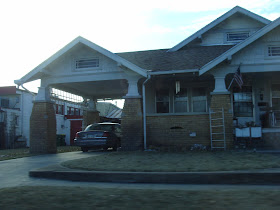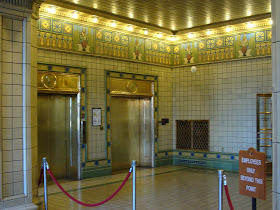
Tucked away, right in the middle of the jumble of streets that head into Downtown, is a one block stretch of street, an alley really, named French Market Court.

French Market? Only five or six blocks north of the more famous Soulard Market, the South Market, known as the French Market presumably because of its location in the Frenchtown neighborhood, was one of two markets built by the City of St. Louis in 1839 to expand market space from the original market on Market Street.

The North Market, known as the Mound Market, was located up on the northside of what is now Downtown.

But does anything survive that could have originally been part of the French Market? The buildings now lining the street seem to warehouses, not market buildings.

I suspect, as Soulard Market took off, the French Market slowly died off, and as the area became more industrial the market buildings at Broadway and LaSalle Streets was torn down. Looking at the Sanborn maps, which are approximately one hundred years old depending on the edition and revisions, reveal large amounts of vacant land along the Court, suggesting that the buildings had only recently been torn down in the last decade before the map was published. I find it hard to believe that there would be so much vacant land otherwise in such a densely settled sector of the city. Seemingly, only the street survives as a remnant of one of the first market spaces in the rapidly expanding St. Louis.

There is enormous potential in these buildings, as considering that most of the urban fabric has been annihilated for Rally's and White Castle parking lots, the relative intact stretch of warehouses and light industrial buildings would be perfect for rehabilitation.

If you have any historic photos or paintings of the French Market, please let me know! There's next to no information out there about the market, and it is a fascinating relic of the past that deserves more attention.

 Valley Center, Kansas is an interesting town north of Wichita, and seems to have been built largely around the 1910's or 20's, as there is an abundance of Arts and Crafts bungalows throughout the center of town. I really like this house, which actually has a port cochere, a rarity on this style of house.
Valley Center, Kansas is an interesting town north of Wichita, and seems to have been built largely around the 1910's or 20's, as there is an abundance of Arts and Crafts bungalows throughout the center of town. I really like this house, which actually has a port cochere, a rarity on this style of house. This cement block building on Main Street anchors this corner of the downtown, across from a massive grain elevator.
This cement block building on Main Street anchors this corner of the downtown, across from a massive grain elevator. I really like this stream-lined, Art Deco brick building which also faces Main Street.
I really like this stream-lined, Art Deco brick building which also faces Main Street. This cemetery, to the east of town, sits in the shadow of a water tower and interstate.
This cemetery, to the east of town, sits in the shadow of a water tower and interstate.
















































